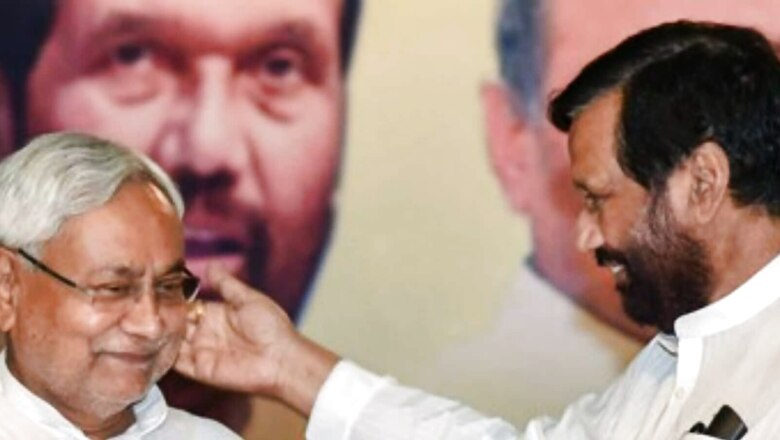
views
As Bihar chief minister Nitish Kumar switched sides to the Rashtriya Janata Dal after severing ties with the Bharatiya Janata Party, Lok Janshakti Party (Ram Vilas) leader Chirag Paswan has been in an attacking mode against the Janata Dal (United) co-founder. Chirag said that Nitish has “zero credibility” and that the state should see a fresh election. He even questioned Nitish’s ideology. However, the son of former union minister late Ram Vilas Paswan has perhaps forgotten his father’s political life which was also full of alliance flip-flops.
Apart from their common roots in Bihar, both Nitish and Paswan share the socialist class of politicians. Another thing similar in them was the propensity to switch sides and shift loyalties to stay politically relevant.
Paswan was so famous for his shifting loyalties that at one point RJD co-founder Lalu Prasad Yadav called him a “Mausam Vaigyanik” (weathervane) who switched sides as political weather changed. These three – Lalu, Nitish, and Paswan – were the products of the JP Movement.
Further, Narendra Modi, now the Prime Minister, has been the reason that both Nitish and Paswan had left the National Democratic Alliance (NDA) at different points in the past – Paswan in 2002 and Nitish in 2013.
Nitish Kumar’s journey in politics and shifting loyalties
Nitish became the chief minister of Bihar for the first time in 2000 for a very brief period of seven days. This was in support of the NDA. In 2005, the JD(U)-BJP alliance came into power in Bihar. This partnership continued in 2010 as Nitish returned to the helm of affairs.
The JD(U) had enjoyed the BJP’s support since the late 1990s until it walked out of the National Democratic Alliance (NDA) in 2013. Nitish pulled his party out of a 17-year-old alliance with the BJP because he was reportedly unhappy with the rise of the then Gujarat chief minister Narendra Modi. Nitish also sacked the then deputy chief minister and all the ministers from the BJP from his cabinet. Nitish announced the exit after the BJP appointed Modi as the chairman of the Lok Sabha election campaign committee.
Barring a brief hiatus, Nitish has been the CM of Bihar since 2005. Even during the brief period when he was not holding the reins, it was his party that was in power. After the 2014 Lok Sabha polls, Nitish resigned from the position and Jitan Ram Manjhi took charge as the state’s chief minister. In just nine months, Nitish was back in power in February 2015.
In the 2015 polls, Nitish joined hands with arch-rival Lalu’s party and formed the government. In 2017, in a dramatic move, Nitish dumped the so-called Mahagathbandhan (grand alliance) and rejoined the NDA. They stayed together and fought the 2020 assembly polls. Despite winning fewer seats than the BJP, the JD(U) was given the post of chief minister.
Now in 2022, Nitish resigned from the post of Bihar CM after breaking ties with the BJP-led NDA, and formed a new government with the RJD, Congress, and others. He took oath as the chief minister of Bihar for the eighth time earlier this month. Despite switching sides and winning fewer seats than the RJD, which emerged as the single-largest party in the previous polls, Nitish continues to be the chief minister.
While Nitish has preferred remaining in the state, his political senior Paswan had been in the union cabinet as he switched sides between the Congress-led United Progressive Alliance (UPA) and the NDA.
How Ram Vilas Paswan had a similar journey
Paswan, who was first elected an MLA in 1969, was active in politics for over 50 years and had served as a cabinet minister of six prime ministers under UPA and NDA governments.
First elected to the Lok Sabha in 1977, he was re-elected a total of nine times until 2014. He was also a two-time Rajya Sabha member.
In the 1989 polls, he made it to the union cabinet as the labour and welfare minister in the short-lived third-front government of VP Singh. During the 1996-98 government, he was the cabinet minister (railways) and held the post of parliamentary affairs minister.
When the BJP came to power for a full term in 1999, Paswan, along with the entire Janata Dal faction, switched loyalties and he was made minister for communications. He also became the coal and mines minister under the Atal Bihari Vajpayee government.
However, in April 2002, he quit both the union cabinet and the NDA citing the government’s failure in dealing with the Gujarat riots. After his exit from the NDA, Paswan gravitated towards the Congress-led UPA. The alliance came to power in 2004 and he was appointed the minister for chemicals and fertilisers and steel under the Manmohan Singh government. However, the relationship was strained during UPA-2.
In 2014, a little before the Lok Sabha polls, Paswan’s LJP became the BJP’s first new ally. The NDA came to power in 2014 and, yet again, Paswan took charge as a cabinet minister. He had been a union minister until his death in 2020.
Despite the two being known for switching sides, in 2005, Paswan refused to support Nitish in government formation in Bihar and the state went under President’s Rule. In February 2005, when Bihar went to polls, the elections threw a viciously fractured mandate. The JD(U)-BJP alliance, with 92 seats, fell far short of a majority and the RJD emerged as the single-largest party with 75 seats. The LJP had won 29 assembly seats and refused to go either way. The elections later that year made Nitish a household name in the state.
Read the Latest News and Breaking News here















Comments
0 comment